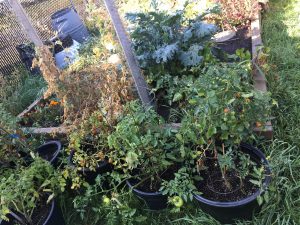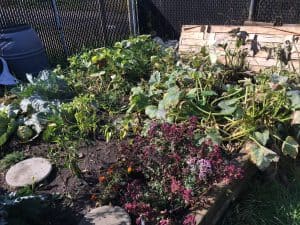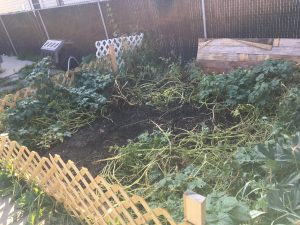Putting a garden to bed for the winter
After a summer of enjoying the fruits and vegetables of our labours, autumn is the time to prepare the garden for spring by harvesting, pulling up plants, and composting.
While some plants can endure the frost, others can’t. Harvest plants such as tomatoes, peas, peppers, and squash as they ripen. Root vegetables can stay in the ground until it freezes.
Preparing the garden for spring is the last thing to do before winter.
“This is the last thing in the fall, after all the edibles are harvested as temperatures start hovering a few degrees above zero during the day,” explained Gérard Forget, Alberta Avenue Community Garden coordinator. Each year is different, but this work is generally done between mid-September to mid-October.

After harvesting your plants, compost.
Mark Stumpf-Allen, compost programs coordinator with the city, said, “As crops ripen and your garden is emptied, you should immediately plant more seeds.” He continued, “Remember, roots are one of the three soil builders and so never leave your soil without active root systems.”
After harvesting root vegetables in mid September or October, bury organic waste and leaves where the plants were to help protect the soil against the spring thaw cycles and prevent weeds.
“If you leave soil bare through fall and winter, you’re inviting weeds to do the soil building work for you,” Stumpf-Allen said, explaining weeds are nature’s way of filling space and helping to repair damaged soil.

Carrots and parsnips can be left in the garden, but Forget suggests picking them in the springtime, otherwise they will go to seed. Forgotten potatoes and tomatoes will also grow.
Forget said the prep work is important because it “also accumulates moisture from the snow for the next growing season.” If there are pests in the soil, disturbing the soil right before a frost will help kill some of them over the winter.
Stumpf-Allen said soil on the city’s north side is a “clay-structured soil, which is excellent for growing food.” But it’s important to work the soil and build it up year-round to get it “the way it was before modern agricultural methods began destroying it.”
“The first rule of soil building is to take nothing away. All the dead material is food for your soil,” Stumpf-Allen explained. “You can leave it alone, let it decay and deal with the leftovers in spring, like nature does. You can pull it up and bury it in topsoil like old-timers did, or you can compost it like scientists do.”
Any organic matter can be composted, although you shouldn’t compost dog, cat, and human feces or diseased plants. Stumpf-Allen suggests beginners stick to simple composting, like using egg shells and plants. He added, “things that should not go into your compost pile are things that will harm your soil or interfere with plant growth.”

Forget added, “things to avoid are weeds with mature seeds that will germinate if spread back in the garden.” Examples include stinkweed or weeds that spread by their roots.
Mix compost in the top few inches of the soil. “It helps hold in moisture in the soil so it is available for plants,” said Forget. This also helps improve the soil structure if there is too much clay.
As Stumpf-Allen said, “The soil is telling you what it needs, you just have to take the time to listen and learn the language. Easy-peasy, right? Ha ha, nope.”
Featured Image: Prepare your garden for winter between mid September and October. | Stephen Strand







